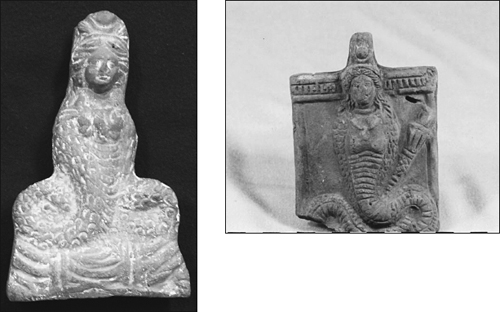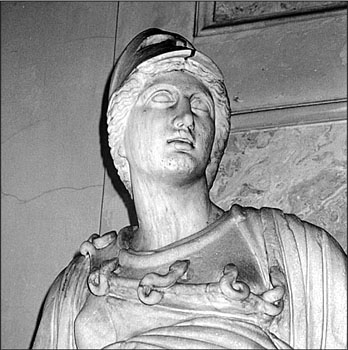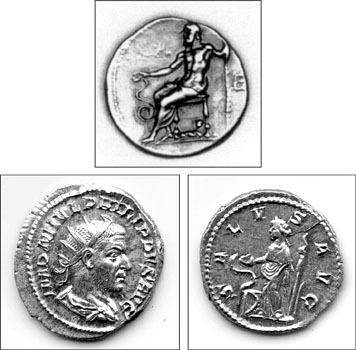Read The Good and Evil Serpent Online
Authors: James H. Charlesworth
The Good and Evil Serpent (31 page)
Other gods beside Isis were portrayed as a serpent, and this will be evident later; for now, a short synopsis would help introduce the following summaries. Typhon is conceived with the body of a serpent below the waist and sometimes with anguipedes (serpents as feet).
35
Serapis (or Sarapis) sometimes appears as a large upraised serpent with a goatee.
36
Amphiaraos is shown as a serpent as he heals Archinos from his sickness.
37

Figure 50
.
Left
. Isis with Serpent’s Torso. Circa 100 BCE. Reportedly found south of Ashkelon. JHC Collection
Figure 51
.
Above
. Isis with Serpent’s Torso. Circa 100 BCE. Reportedly found near Jerusalem. JHC Collection
The imagination of the ancients was not chaotic or without any control. It is precarious to suggest that syncretism was in full force. We should talk about influence from one culture on another or of acculturation and assimilation.
38
Athena, for example, is never portrayed with a uraeus, the upraised cobra that signified divinity in Egypt. This fact seems impressive since Mercury was imagined sometimes with a uraeus
39
as were Hermes (his Greek equivalent)
40
and Isis.
41
Depictions of Gods and Goddesses with Animals
It is well known that the ancient gods were often portrayed with animals. Neptune is often depicted with a dolphin,
42
and Poseidon with a fish.
43
Prometheus is shown with a vulture.
44
Castores is associated with a horse.
45
Leda is almost always pictured with a swan,
46
sometimes copulating with a large male swan.
47
Hyakinthos is imagined riding on a swan,
48
as is Kamarina,
49
and sometimes Aphrodite.
50
Europa is associated with a bull,
51
and Theseus is frequently conceived as fighting a bull.
52
Selene or Luna (the moon) is sometimes depicted in a chariot pulled by oxen.
53
Romulus and Remus are imagined with a female fox.
54
In our search for the meaning of serpent symbolism, a brief digression exploring the symbolic meaning of the fox helps frame our quest. Is the fox only a symbol of the founding of Rome? Did it always mean that, or was it merely an ornamentation, as it is today on some shelves and desks? F. Cumont suggested that the twins’ wolf denotes a type of eternity.
55
If so, then it behooves us to follow the lead of A. D. Nock and ask if we are intended to contemplate “absolute eternity,” whatever that might mean among an array of options, the eternity of “invincible” Rome or our own personal immortality.
56
With Nock, I am convinced that Cicero was correct to point out that Rome’s eternity was tantamount to the universe’s eternity, and that a person would only be eternal because of his or her quality of being Roman; that is, as a Roman permanently linked with so-called eternal Rome.
57

Figure 52
. Athena. Early Roman Period. Courtesy of the Hermitage. JHC
Telephos is shown with a deer.
58
Artemis is depicted with a hunting dog.
59
Athena is portrayed with serpents as fringes on her garments.
60
She is imagined with serpents rising from her shoulders,
61
joined to make a necklace,
62
or coiled on her shawl.
63
Athena is also one of the war goddesses. She has serpents on her hel-met.
64
Serpents are shown, infrequently, on the shields of her warriors,
65
and sometimes fighting for her.
66
Occasionally, a serpent is portrayed encircling a tree before her.
67
Most important, a serpent is portrayed coiled upright next to her shield that is held by her left hand and resting on a surface.
68
This conception seems significant because she was most likely seen in this fashion by the thousands who visited the Parthenon in Athens. There stood a colossal statue of Athena, in gold and ivory, made by Pheidias in about 400
BCE
and she was represented by serpents.
We can catch a glimpse of Pheidias’ masterpiece through the “Varvakeion Athena,” a marble copy of the Athena Parthenos he had made for the Parthenon in about 447
BCE
. The copy dates from the second or third century
CE
. It is chryselephantine (made of gold and ivory). It bears thirteen serpents on the chest, with a Gorgon. One serpent appears on each wrist. A large serpent is depicted on the inside of her shield and a Gorgon on the outside. Two serpents are on the belt. The chest garment
(aegis)
is decorated as snake skin, similar to the skin of a large serpent on the lower right. The profusion of serpents is remarkable.
69

Figure 53
. Two Silver Coins.
Above:
Asclepius feeding a snake, courtesy of the Numismatic Museum in Athens.
Below:
Philip I with Salus, in the Charlesworth collection. The serpent depicted the prosperity Rome in the third century CE brought to those in the world. JHC Collection
A serpent is often shown along with Minerva and Athena, probably because of the association of these goddesses with the earth. This survey of gods with animals opens a deeper appreciation of the appearance of gods as serpents, as partial serpents, or with serpent images.
Most of the gods were linked with the awesome wonder of the serpent. Jupiter is sometimes shown with a serpent on his right shoulder.
70
Dionysus is depicted fighting with the assistance of one or more serpents.
71
Bacchus,
72
Dioskouroi,
73
Hecate,
74
and Harmonia
75
are imagined on coins with two serpents. Prokles is portrayed with a serpent, or dragon, on her head.
76
Salus, the Roman personification of prosperity, is conceived in ways reminiscent of Hygieia; that is (as we shall see), with a serpent eating out of a bowl in her right hand.
77
Lar or Lares is imagined with a large serpent.
78
Minerva, depicted as either a female or a male, is portrayed with a serpent eating out of a bowl held in her right hand,
79
and with serpents fighting with her.
80
She is also depicted with feminine breasts and with serpents crawling upward,
81
as well as with serpents curled around her neck and chest.
82
In a similar fashion, Sirona is portrayed with a serpent draped around her right arm.
83
Thetis is shown with her human husband Peleus, with serpents, or a serpent, biting him.
84
Common themes are highlighted by a serpent moving into the picture.
85
Agamemnon, Talthybios, and Epeios, the builder of the wooden horse for the Trojans, are depicted with a large upraised, coiled serpent that bears a crown.
86
Tiberius is portrayed beneath a menacing serpent.
87
And, as one might imagine, Fortuna is portrayed with animals and her cornucopia;
88
sometimes she is imagined holding a serpent in her right hand and feeding it from a bowl, or philiae, in her left hand (as Hygieia is often depicted).
89
Nephthys is associated with a serpent swallowing its own tail (perhaps Ouroboros) and sometimes with one or two upraised cobras.
90
Harpokrates,
91
Strymon,
92
and Heros Equitans
93
are imagined before a large upraised serpent. Perseus
94
and Kreousa
95
frequently, and Cerberus
96
usually, are depicted with a serpent. Peleus is shown with two serpents in his right hand,
97
and Somnus with a serpent in each hand.
98
Pegasus is frequently shown stomping a serpent and a chimera (a lion with a ram protruding from its back and with a serpent for a tail).
99
Cybele is customarily depicted with a lion, riding a lion (perhaps influenced by the iconography that depicts the Syrian goddess Qadesh),
100
and in a chariot pulled by lions.
101
She is also, notably, shown with a serpent.
102
A stunning example is the depiction of the cosmic triumph of Cybele and Attis that is immortalized on a silver patera from 360–390
CE
. Two serpents appear in the scene. One winds majestically up a column. It has seven curls, indicating its cosmic powers.
103
